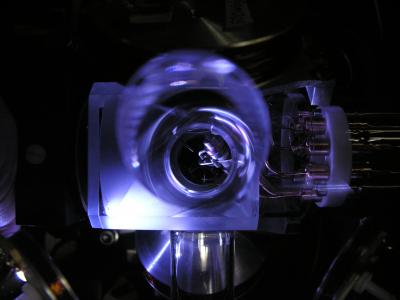Scientists at Physikalisch-Technische Bundesanstalt (PTB) are performing experiments on optical clocks based on the phenomenon of lightwaves and their ability to vibrate rapidly than microwaves.
 This is the ion trap of the ytterbium clock at PTB. Credit: PTB
This is the ion trap of the ytterbium clock at PTB. Credit: PTB
The initial research includes a quantum-mechanic based ‘forbidden’ transition of ytterbium ion and its precise measurement. Depending on this fact, the optical clock measures 17 digits after the decimal point. The results of this outcome have appeared in the scientific journal, Physical Review Letters.
A special forbidden transition has been considered in this experiment. In the ytterbium ion Yb+, the F-state can be active up to 6 years. This extended lifetime allows the observation of an extremely narrow resonance during the laser excitation in this state. A narrow resonance line is mandatory for an accurate optical clock. In 1997, a subsidiary of PTB called the British National Physical Laboratory (NPL), successfully achieved laser excitation of the Yb+-F state from the ground state. The excitation needs a relatively high laser intensity as the transition is strongly forbidden. The electron structure of the ion has been impacted as a whole, and a shift occurs at the resonance frequency. The related atomic clock therefore exhibits a rate based on the laser intensity.
PTB scientists demonstrated that the seamless resonance frequency can be precisely resolved by alternating the excitation of the ion with two different laser intensities. In addition, other frequency shifts in atomic clocks can also be identified. The Yb+-F state shows insignificant shifts due to the special electronic structure of the state, contributing to implement further advancements in this atomic clock. The relative uncertainty of the Yb+ frequency was determined with 7. 10-17, using caesium clocks. The institutes will team with other European partners to further develop this optical clock.
Source: http://www.ptb.de/